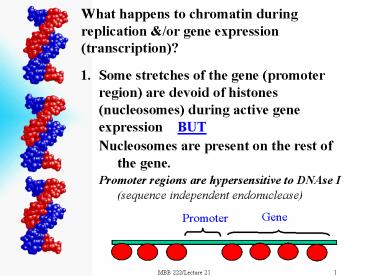What happens to chromatin during replication - PowerPoint PPT Presentation
1 / 12
Title:
What happens to chromatin during replication
Description:
What happens to chromatin during replication &/or gene expression (transcription) ... Model for Chromatin Replication Mathews Fig. 28.17 ... – PowerPoint PPT presentation
Number of Views:75
Avg rating:3.0/5.0
Title: What happens to chromatin during replication
1
What happens to chromatin during replication /or
gene expression (transcription)?
- Some stretches of the gene (promoter region) are
devoid of histones (nucleosomes) during active
gene expression BUT - Nucleosomes are present on the rest of the gene.
- Promoter regions are hypersensitive to DNAse I
(sequence independent endonuclease)
Gene
Promoter
2
- Histones are NOT displaced by RNA Polymerase
- During DNA Replication, as the replication fork
approaches a stretch of chromatin, nucleosomes on
the parental duplex are displaced and new ones
(containing both re-cycled and new histones) are
re-formed on the newly synthesized daughter
duplexes
3
Model for Chromatin Replication Mathews Fig.
28.17
Both old and new histones are used for chromatin
on both daughter duplexes
4
Non-Histone DNA Binding Proteins Other
Chromatin-Associated proteins
- DNA Polymerases - ssDNA binding proteins -
Topoisomerase I II - Helicase - Primase, etc. -
RNA Polymerases - Transcription Factors -
activators suppressors - Factors for ribosomal
assembly - ribosomal proteins - Nuclear RNPs
(RiboNucleoProteins) involved in mRNA
processing - Telomere associated proteins -
Centromere associated proteins - Scaffolding
proteins - Recombination Proteins - Other
Replication
Transcription
RNA Processing
Others
5
Chromosome Structure, Function Transmission
Basic structure of eukaryotic chromosomes
Centromere
Telomere
Telomere
Telomere
Metaphase Chromosome
Centromere ?
Replication - Multiple Origins of replications -
Eukaryotic chromosomes are too large to replicate
from ONE origin of replication.
It would require over ten days to replicate a
chromosome with one ORI.
6
To be fully functional a eukaryotic chromosome
needs - at least one Origin of replication - a
centromere - telomeres 1. Origin of Replication
in YEAST ARS Autonomous Replication
Sequence 11 base ARS consensus
sequences 5-(A/T)TTTAT(A/G)TTT(A/T)-3 This
sequence is repeated multiple times in a 100 bp
region
7
2. Centromere - contains an unique sequence,
usually (but not always) at the midpoint of the
chromosome, (plus repetitive DNA) - The
attachment site for spindle fibers in MEIOSIS and
MITOSIS. - Binding site for kinetochore
proteins
spindle fiber
8
- 3. Telomere
- - Highly repetitive sequences
- DNA sequence that stabilizes the ends of
chromosomes - - 3 OH is unprotected ? susceptible to
exonucleases - Helps to solve the problem of replicating the
ends of a linear DNA molecule. - - RNA primer required for DNA replication. How
to put DNA at the new 5 end?
Confocal microscope image of chromasomes using a
general DNA probe (BLUE) along with telomere
specific probes (PINK).
9
- So after every round of DNA replication, the
chromosomes will get a little shorter -Unless
some other process occurs to lengthen the ends
10
- How telomeres accomplish these tasks?
- Telomeres are repetitive Guanine-rich sequences
that often contain a 3 overhangs - - These sequences can fold back to form unusual
GG base pairs Guanine Quartets - (G-quartet)
- - These structures or the single stranded
overhang itself may be capped by proteins to
stabilize the ends
GG
GG
5
TTTTGGGGTTTTGGGG-3
11
(No Transcript)
12
II. Recruit an enzyme, telomerase- a special type
of reverse transcriptase uses an RNA Template
(part of the enzyme) to synthesize new telomere
sequences on the ends of existing telomeres































